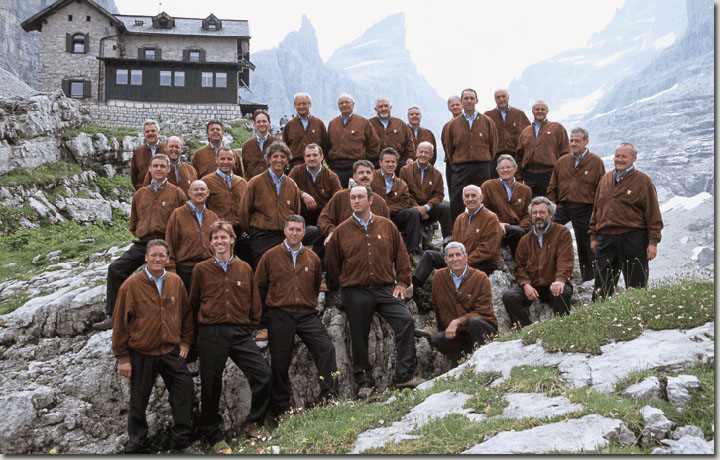The SOSAT Choir was officially founded in Trento, on 25th May 1926 by four brothers, Enrico, Mario, Silvio and Aldo Pedrotti. It kept its original name until 1932, when it was changed into SAT Choir.
The Pedrotti brothers, who had been keen on music since their childhood, used to sing church music in the Cathedral polyphonic choir of their home town, but they also loved to sing by ear all the folksongs of their land among their family members.
Life experiences like being war refugees in Boemia and Austria during World War I, or soldiers during conscription and military service later on, were nevertheless a good chance to get in touch with a lot of folksongs coming from different countries and traditions.
Thanks to numerous and renown musicians like Giorgio Federico Ghedini and Arturo Benedetti Michelangeli, some folksongs were refinedly harmonized and dedicated to the choir.
Several editions of the entire repertory (nearly 300 folksongs) have been printed so far, while recondings cover a long period that stretches from 1933 to more recent times (from 1996 to 2013 seven CDs and a double CD containing 181 folksongs have been released).
Enrico Pedrotti conducted the choir until 1938, when the place was taken by his brother Silvio for over fifty years. At present, the choir is conducted by Mauro Pedrotti, Mario's son and Silvio's nephew.
The SAT Choir has given more than one thousand concerts in the most prestigious concert halls and theatres in Italy, Europe (Austria, Belgium, Czechoslovakia – now Chech Republic – Denmark, Finland, France, Germany, Great Britain, Holland, Russia, Switzerland) and America (Brazil, Mexico, the United States, Canada).
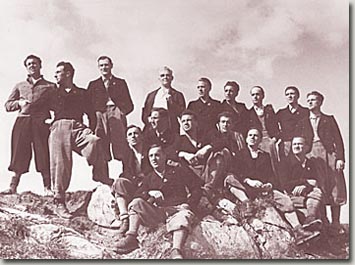
1926-1932
Those were the years of the "first steps" – although still uncertain after the unexpected success of the first concert – the years that were to confirm an identity already outlined in the "Gran Corale Società" and then passed onto the SOSAT Choir. In that period the co-operation with Luigi Pigarelli and Antonio Pedrotti was decisive, since they understood the potentiality of that small group of choristers. They skilfully worked on the repertory as well as on the elaborations, starting from the arrangements made by the singers "by ear" – maybe simple ones but already showing the musical developments to be. Thanks to the Ranzi brothers, who were studying in Turin at the time, La Montanara by Toni Ortelli was brought to Trento, where it was harmonized by Luigi Pigarelli. The SAT Choir and La Montanara thus joined to form that indissoluble pair that nowadays everybody still praises. Even though in the beginning concerts were not as frequent, the choir performed in Rome (1979), in Bolzano and Cortina d'Ampezzo (1930), in Milan and in Brescia (1931), in Belluno, Trieste and Fiume (1932).
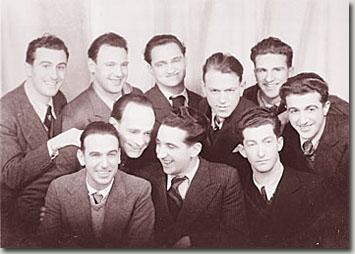
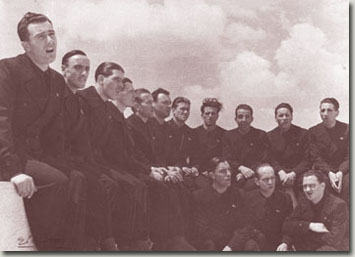
1933-1938
The most important events in that period were the decision to change the official name in 1938 – even though it started to be used years before – and the experience of the first phonographic recordings. Before the raptured and almost incredulous eyes of the young choristers, the first 78 revolutions LPs were released by Columbia. Nine folksongs altoghether. Among them La Paganella, La Sposa Morta and La Montanara. It was a big acknowledgment for the time. The music industry world would obviously pay attention to any new fashion on the market but, at the same time, couldn't avoid considering the eventual bargain one could get. Another milestone of that period was the acquaintance of Arturo Benedetti Michelangeli. It happened in 1936 during a concert the choir was giving in Brescia. The great pianist to be, who was then 16, performed during the interval accompanied by his brother on the violin.
1939-1952
If, on one side, the tragic period of World War II slowed down the performances of the choir, on the other it didn't lessen their enthusiasm. In fact, Mario and Silvio Pedrotti were ordered by the General Headquarters to start training the choirs of Valfassa and Trento battalions. When the war was over going back to performances on a grand scale was seen as a way to take revenge against all the political and economic difficulties people had gone through. Concerts were given both in Italy and abroad, so that a lot of people could get in touch with a new way of thinking and performing folksongs (particularly important among them was the taking part in the Youth Festival in Prague). The repertory was enriched by some of the first harmonizations of the great Arturo Benedetti Michelangeli, who had started teaching piano at Bolzano Conservatory in 1949 (La Bella al Mulino, La Pastora e il Lupo, La Scelta Felice).
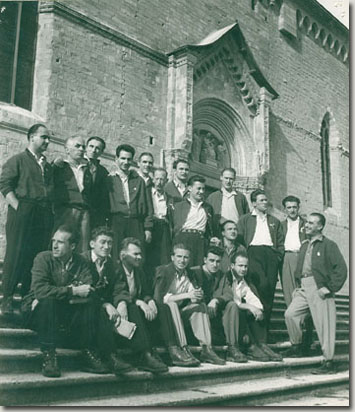
1953-1964
The event that left a mark on that period was surely the winning of the "Guido d'Arezzo" International Choirs Competition. An unexpected prize that was, and therefore much more valued, since the choir won it despite their rivals were technically and musically more prepared or, in some cases, already famous and conducted by refined musicians. A small group of mountaineers dressed in zouave trousers and boots, mostly unable to read a score, were nevertheless able to compete with and win over their competitors and that means that the impression their voices made on the jury must have been great. Also Renato Dionisi joined the group of harmonizers: his Ninna Nanna – first song harmonized almost unwillingly ("...I didn't really understand what they wanted from me... since my studies and models were so far from the land I was about to discover...") – still remains one of those masterpieces which is always asked for an encore during concerts. That was also the time for the choir to be introduced in Germany. The first concerts in Stuttgart and Munich in November 1956 were soon followed by other performances both in theatres and on television. In 1960 the choir became part of one of the most important Italian record company (RCA Italiana). The recording in Rome of the LP "La su per le Montagne", marked the beginning of a co-operation which was to last a very long time.
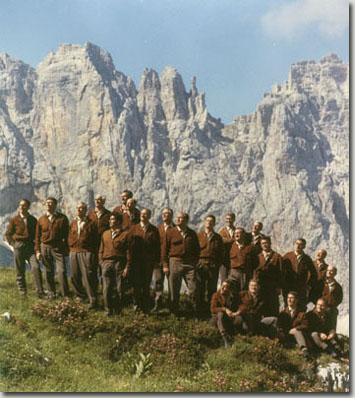
1965-1974
Those were the years of both musical development and refinement, as well as of new experiments. The repertory improved in quantity and in quality, and harmonizers like Andrea Mascagni, Bruno Bettinelli, Lino Liviabella, Teo Usuelli joined the group. The idea of renewing the choir accepting pupils who had ended their training proved to be the right one: being open minded meant keeping the choir young and securing it a long-lasting success. The choir was asked more and more concerts, but it was not so easy to meet everybody's wishes and abandon that "amateur" approach to an activity which, from the very beginning, had been conceived as a pastime. Each member of the group had families and jobs they felt committed to. Because of this they had to give up an offer of twenty concerts in Japan – a tour that would have kept them away from home for at least forty days!
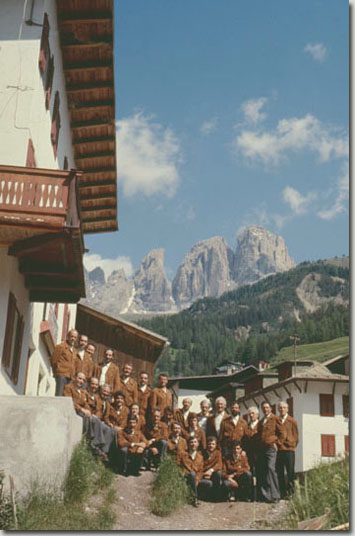
1975-1980
In those years the choir, focused on recordings. Several LPs containing old and new folksongs were released by RCA. The result was a refined collection, very much praised by connoisseurs. Among the numerous concerts abroad, those in Germany and Switzerland were particularly important. In Italy the choristers sang in Turin, Trieste, Florence, Varese, Ivrea, Pesaro, Mantua, Cremona where the best theatres and concert halls gave them the possibility to show their accomplished unity in terms of phrasing, dynamism and rhythm.
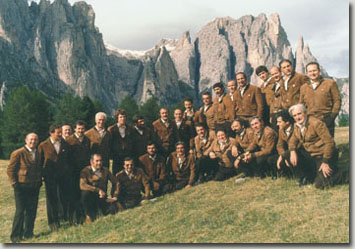
1981-1988
Berlin, Koeln, Saarbruecken, Coira welcomed the choir in Europe again. But those were the years of the transoceanic journeys, which led the choir to New York, Washington DC and Hazelton (USA) in 1981. The following year they gave concerts in Toronto and Ottawa (Canada). Meeting the emigrants from Trentino was a moving experience for them, but also the American and Canadian audience fell in love with the spontaneous authenticity of both the choristers and their songs. Their cultural message flowed naturally despite linguistic obstacles.
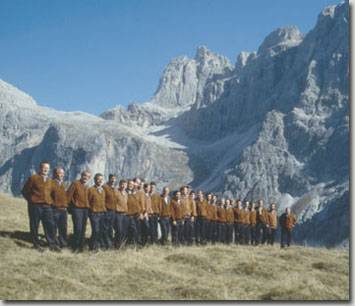
1989-2006
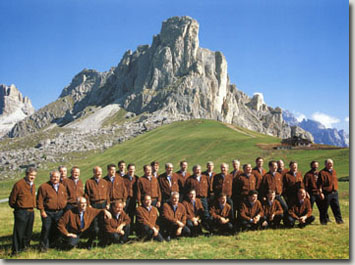
In 1988 Silvio Pedrotti retired after a career lasted fifty years. His place was taken by his nephew Mauro. The choir got bigger thanks to the arrival of new choristers and, after a short period of re-adjustment to the new choirmaster, it started its activity again. The overall impression was that both style and interpretation had been kept the same (one must remember that Mauro had been working as Silvio's vice-conductor for a long time). The only problem that aroused was due to the fact that the enlarged choir needed to look through all those phonographic recordings which, in some cases, were more than forty years-old. A long work thus started. All the folksongs were deeply studied and analyzed. Scores were strictly respected but, thanks to new technologies and a more modern interpretation, several monographic CDs were produced. The nineteen folksongs harmonized by Arturo Benedetti Michelangeli were followed by Antonio Pedrotti's and Renato Dionisi's monographs to end, in 2005, with the one by Luigi Pigarelli.
